[originally posted 12 Oct 2012 02:30 Copyright Øivind Tøien]After my old worn 55mm f/3.5 Micro Nikkor got mechanical (not oil) problems with the aperture mechanism I decided that >32 years of service was a respectable retirement age. I went on ebay a got myself a beautiful replacement that hardly showed signs of use for $55 + shipping. Interestingly, although it was of the latest series listed by Roland and a serial no only about 600 before my old one, the PK scale is orange vs off-white, and the barrel has a slightly more matte finish. Performance is very similar except for a more accurate aperture before chipping:
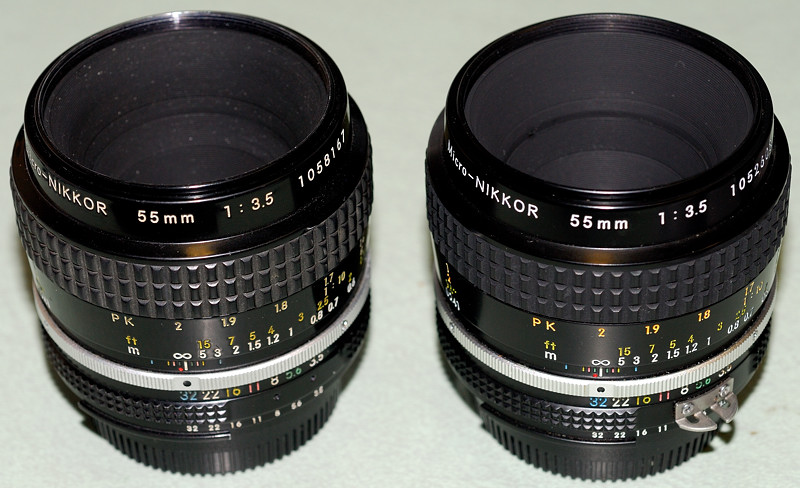
Now on to the disassembly. If the patient (left) is going to die (or retire) there is little to loose by trying to help him, and it provides a good exercise. After first chipping my new 55mm I went on with the disassembly of the old one. Keeping in mind Erik's reminder to document everything with images, the new 55mm was taken into use. (I have previously looked for such documentation on this lens without finding anything).
The set screw on the front ring that becomes visible when fully extended is made of very soft metal, had partly disintegrated and had to be dremeled out. Once the front ring is removed the whole optical assembly comes out, just as with my 105mm f/2.5 AIS:

There is limited access to the helicoid inside:
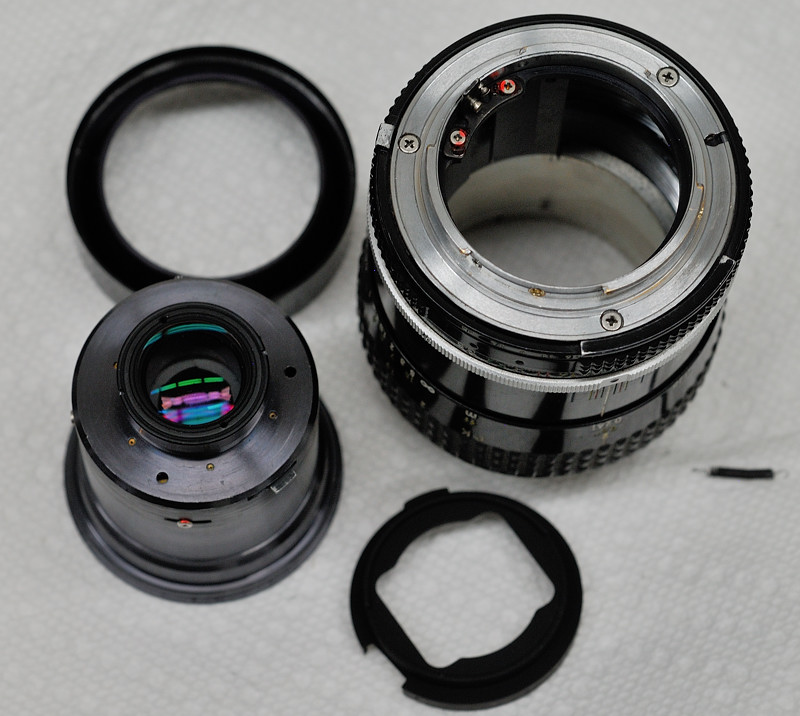
It became clear that opposed to the 105mm the helicoid is not accessible in the front without taking the focus ring off, by loosening the 3 screws under the rubber grip:
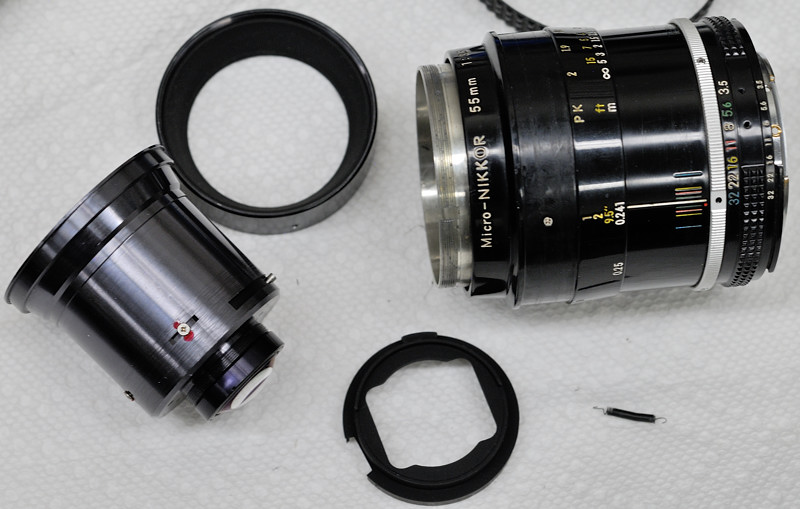
After removing the focus ring the helicoid becomes visible:

This is what the focus ring looks like inside. (It could look like it would be difficult to get in position during reassembly, but it just snaps in once rotated to the right position):
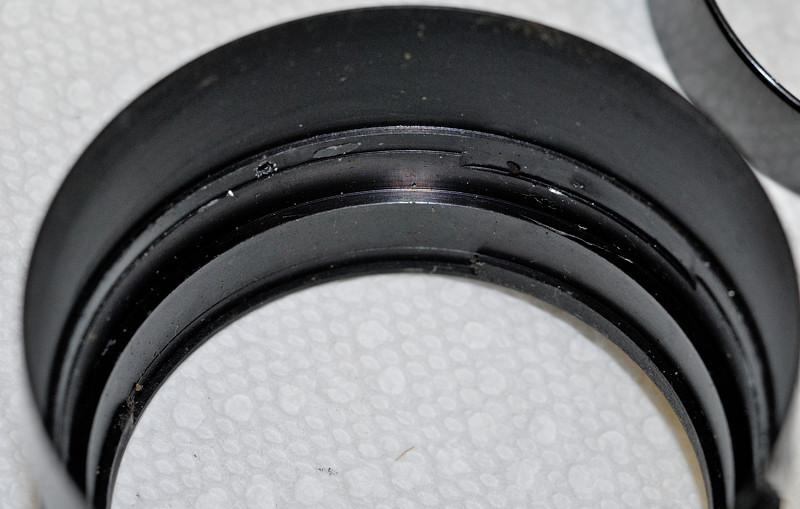
The grease on the helicoids was very dirty. So best to take it completely apart. But first the separation points have to be marked!!
Lower/outer helicoid marked (left):
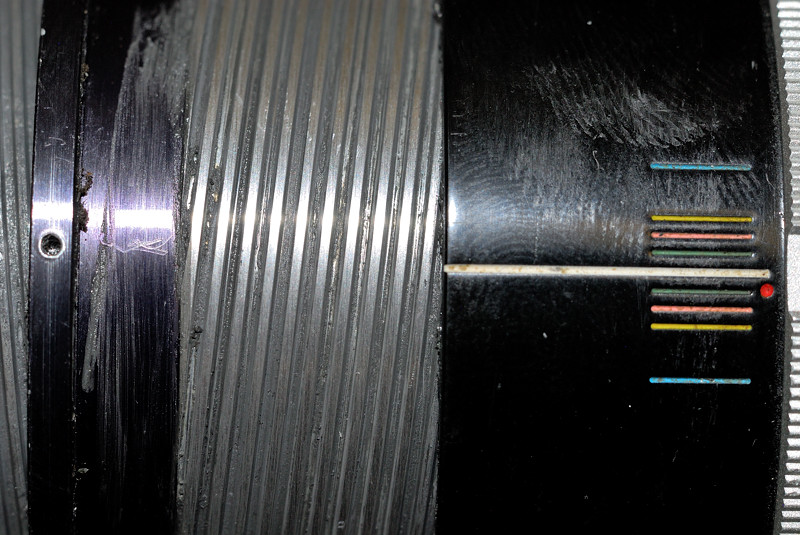
Upper/inner helicod marked (right):
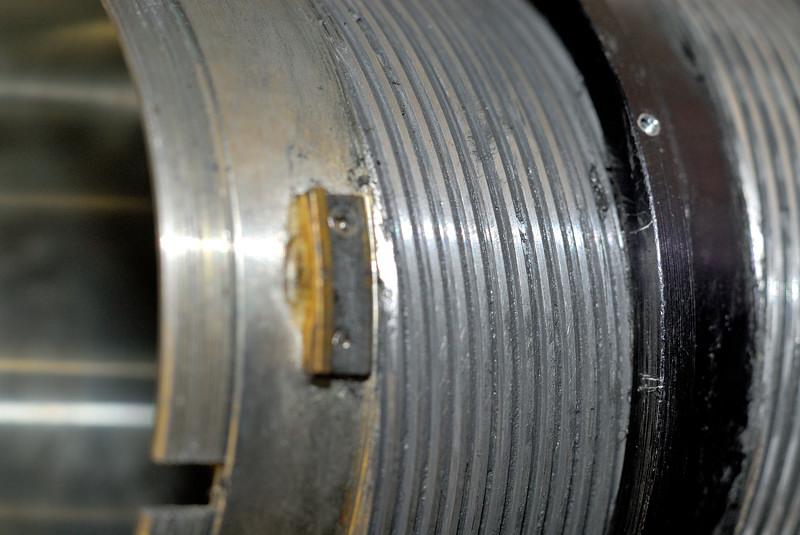
Here is the bottom part after the helicoid came out. I later took the mount off (not shown in any of the images) to get the stop down coupler out of the way. There is still the aperture coupler and focus follower in the way, and the lower part can if desired be further disassembled, but it can mostly be worked around during cleaning and re-lubrication:

"Exploded" view after first cleaning:
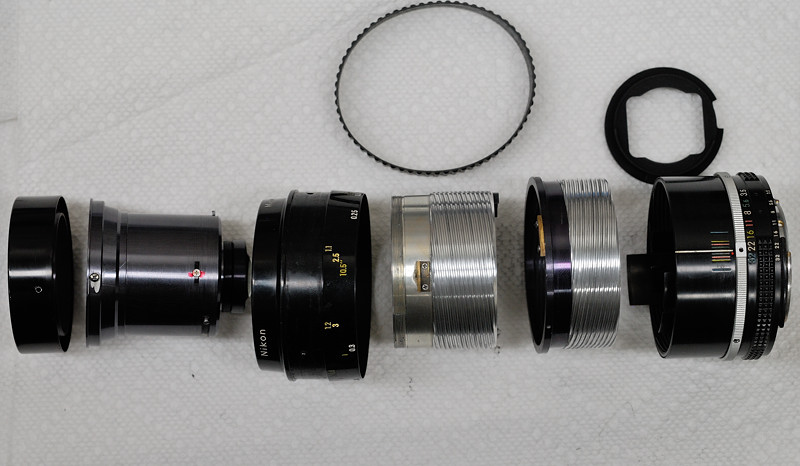
The helicoid was then re-greased and reassembled according to the marks. There is a point where the focus follower engages and it is a bit tricky to rotate everything in the right position up to that point. (Tip: Rotate the black ring in the middle while keeping the top part in position relative to the bottom.) Then the focus ring has to be positioned (see above; I found it easiest to do this with the helicoid screwed all the way down) and the 3 screws fastened.
The optical assembly that had been kept out of the way up to now was dropped back down into the helicoid, guided by a screw:
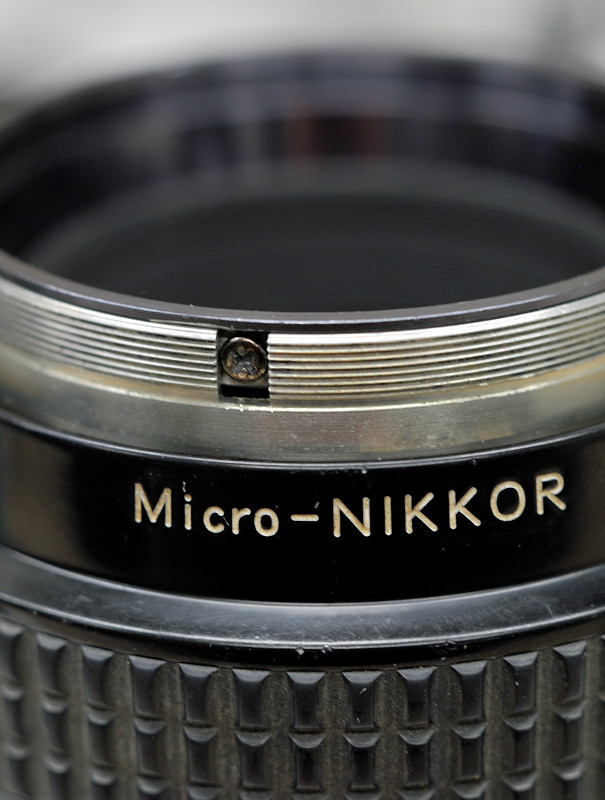
On the 105mm f/2.5 AIS this screw is an eccentric screw that will determine the rotation of the optical assembly, thus act as fine adjustment for the stop down lever. On the 55mm it is fixed*. (*Edit: I did not check the screw's properties carfully, and similar eccentric adjustment present on my 50mm f/2 was very diffucult to detect visually when I checked it). Instead the stop down lever is adjusted at the mount:
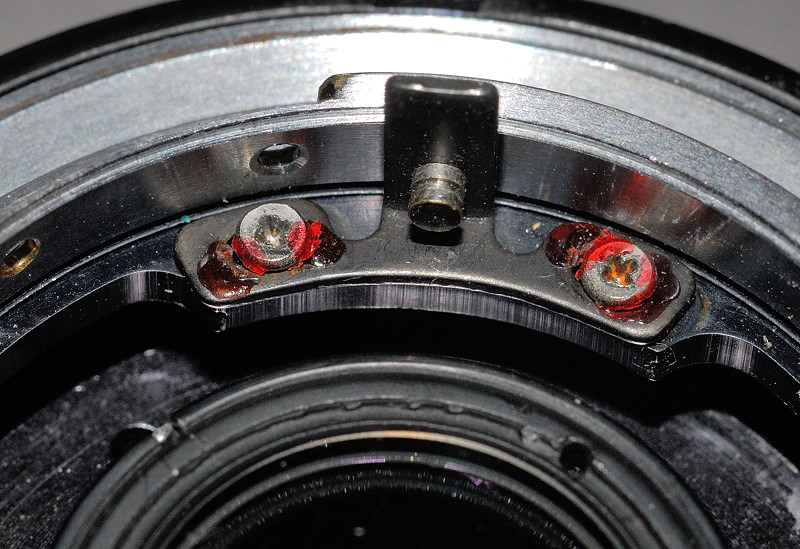
The front ring was tightened again (but I had to do without a setscrew) and finally the mount came back on:
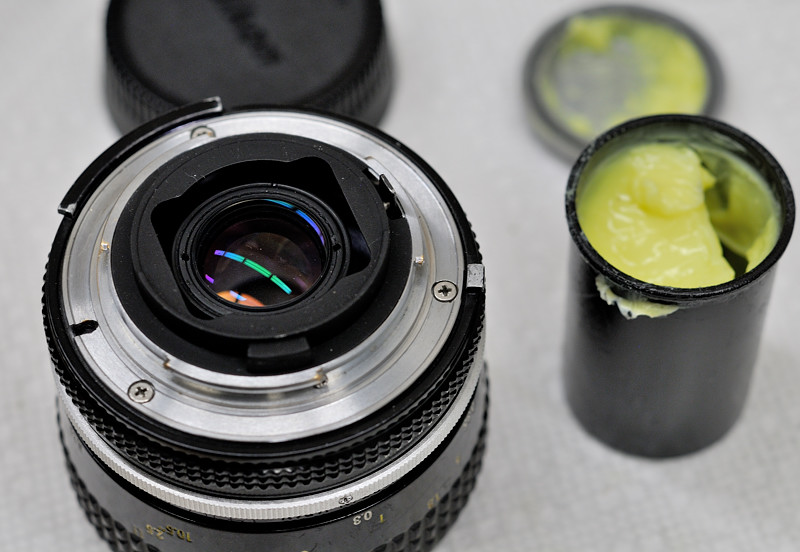
Actually it wasn't quite that easy. When I the first time re-greased, I had absent-mindedly grabbed the wrong container; it was the one with low temperature bicycle grease....

The focusing of course became too stiff. So the whole process with cleaning and re-greasing had to be repeated again, this time with the the "bulk" grease from US camera. That was still pretty stiff, but usable. The long helicoids of these macro lenses probably require very thin grease to be as light as my "new" 55mm and as the old one once was. I will leave it for now as it is in partial retirement. The aperture action seemed to improve somewhat, but I still do not think it is completely reliable, and can possibly act up at any time.
Back to my "new" chipped 55mm, I found that the aperture stop down lever needed adjustment for optimal chipped operation. When I got it it was really "kicking", indication that the lever was hitting in wide open position. After a couple of adjustments (the marks show the initial position) I ended up with moving it as far left in the image as it went (after loosening the screws).
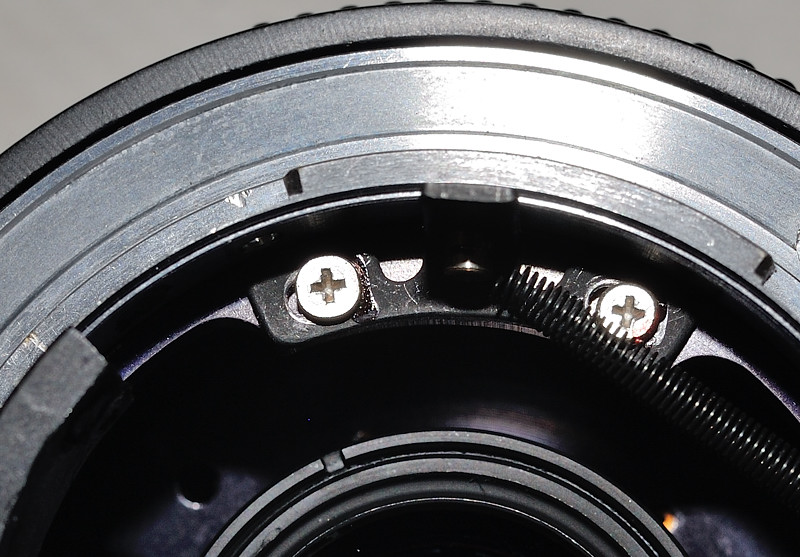
Testing shows that set from the body, this provides linear aperture control and correct exposure from wide open at f/3.5 to f/11. This is pretty good considering that it is an AI lens. Then it gradually underexposes at f/13 and f/14 until it is 2 stops underexposed at f/16, where upon it recovers to one stop under at f/22, and correct again at f/32. Obviously effective aperture at f/16 is minimum of f/32. This could be fixed by the trick of setting aperture on the lens in addition to the body, however I hardly ever use nominal f/16 on my DX bodies so this is not a problem.
Finally an image captured with my re-greased 55mm of the "new" 55mm with a Bjørn mikro chip in a long contact block:
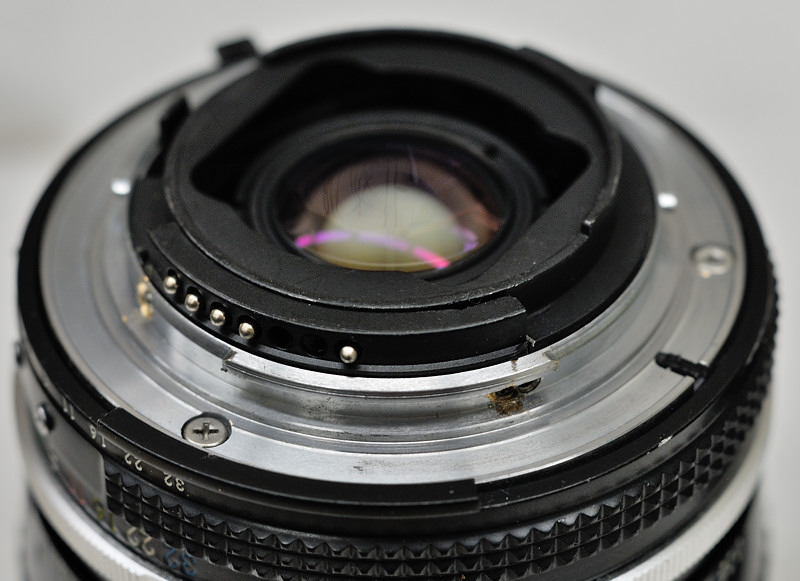
(Baffle is from the old lens that had temporarily been chipped).
---------------------------------------------------------------------------------------------------------
[Some selected comments resulting from the thread] 'M4cr0s', on 13 Oct 2012 - 02:04
"Any idea how close (or not so) the 50 2.0 Ai-S would be to this construction?"[otoien 13 October 2012 - 03:15]There is only the 50mm f/2 AI and pre-AI; I have the pre-AI version that I have AI-ed.
The principle is the same. The set screw for the front ring is facing forward:
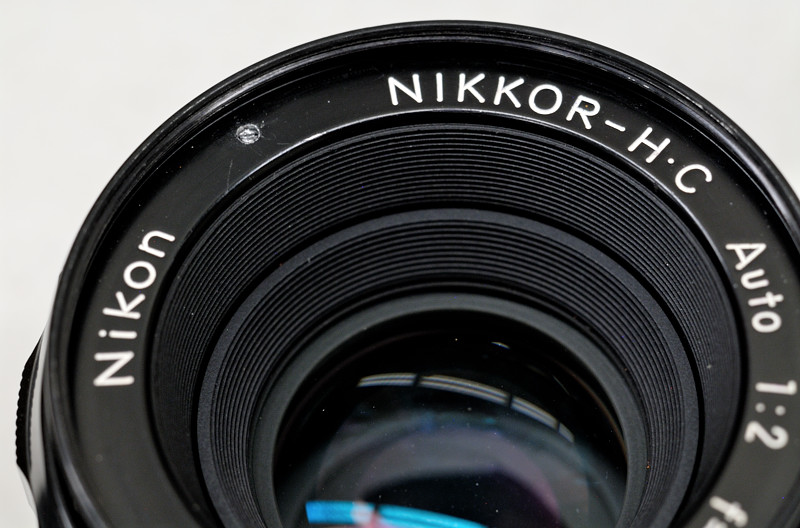
The optical assembly comes out in the same way. Note the the screw to the left determining rotation of the assembly. As on the 105mm f/2.5 this an eccentric screw. There is no adjustment on the stop down lever as on the 55mm f/3.5 micro AI. This is as far as I have gone, as the lens did not require re-lubrication.
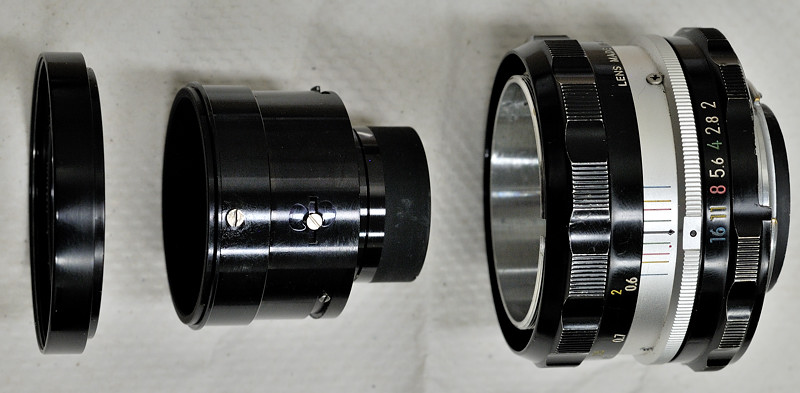 'M4cr0s', on 13 Oct 2012 - 07:07
'M4cr0s', on 13 Oct 2012 - 07:07
"I got 3-4 different kinds of grease and an equal number of oils. Most the greases are the typical lithium based kind, both white and the green-black-blueish "marine" variety. Plus a PTFE (teflon)-lithium mixed one. All are quite stiff in terms of viscosity. Any recomendations for a suitable grease?"[otoien 13 October 2012 - 23:59]I have not used any of the following bookmarked from previous research:
Micro-tools is a good starting point:
http://www.micro-tools.com/store/item_detail.aspx?ItemCode=HG-10http://www.micro-tools.com/store/P-HOBBY-KIT/Lubricant-Kit-Hobby-Light-High-Grease.aspxhttp://www.micro-tools.com/store/P-728J/Lubricant-Grease-Rheolube--2oz-Tube.aspxSearch for "helical grease" in the European store:
http://www.micro-tools.de/index.php?stoken=65D9CA04&force_sid=&lang=1&cl=search&searchfieldname=3d1d8af3340c0831726e3a3f50eb7&3d1d8af3340c0831726e3a3f50eb7=helical+grease&searchcnid=&searchmanufacturerSome other sources i found though searches or in fora:
http://www.newgateonline.com/catalogsearch/result/?q=helical+greasehttp://www.precisionspindle.com/datasheets/Kluber_Isoflex_Super_LDS_%2018.htmhttp://www.lubekits.com/?load=storeLook down the page for "Damping Grease Kit"
Again, I have no experience with these, it previously just came up through some research. Pretty expensive for the quantities sold. The grease does not only need to have low enough viscosity, but also good dampening properties for manual focus. (An AF lens would be a different story). The viscosity may need to be selected based on the type of helicoid, e.g length/size and if it is a double one featuring CRC like on the 55mm f/2.8 AIS.
The grease above was some I got from UScamera in a film box after calling them; it may have been <$10 as I recall. It may be suitable for smaller helicoids. The 55mm has now about the same resistance as my 105mm f/4 AIS as it came from ebay, which is fairly stiff but works well for that lens. My limited experience so far has been that the AIS lenses that I have aquired have tended to be stiffer than AI counterparts. It is also a matter of preference. As I recall, Bjørn did at some point advice against re-lubricating a 125 180mm APO Lanthar that had very stiff focusing - a too light one can be difficult to hold in position.
Erik Lund 05 November 2012 - 07:19
"Thanks for the detailed shots and description!
I use S10 grease from Micro Tools for all helicoils, it is a bit light but works really well" [otoien 05 November 2012 - 20:28]Thanks for the comment Erik. To begin with I thought you wrote $10 grease and was going to look for it, realising soon it is the S-10 grease

at $32.52. Well, perhaps I might get some of it anyway, can probably do quite a few lenses with it. Next up will be my 200/4 AIed which has a pretty large helicoid.
Erik Lund 05 November 2012 - 23:50
"I would guess that it is enough grease for 100 lenses at least... "[otoien 06 November 2012 - 04:54]Interesting, 8g did not seem like much.
Erik Lund 06 November 2012 - 05:03
"I have one short haired brush of a very good quality that I reuse for applying grease, to be able to apply just the right amount.
Thus less grease is potentially wasted... "[otoien 06 November 2012 - 05:06]Yes, my toothbrush absorbed quite a bit of grease.

Thanks for the tip.
Erik Lund 06 November 2012 - 05:09
"One like this for oil painting, no loose hairs allowed! "[otoien 06 November 2012 - 05:11]Thanks!